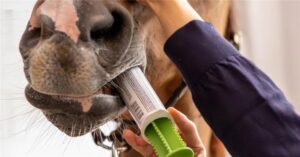
Gastro Pellet: Stomach Well-being Starts in the Mind
Anyone who spends every day around horses knows it well:…
Feed and products in 25kg bags excluded
Bank transfer | Paypal | Credit cards

It is an amino sugar, that is a compound our body produces from glucose and glutamine. Glucosamine is considered as one of the most widespread monosaccharide substances in nature, for it is present mainly in crustaceans and arthropods shells, but it can also be found in mushrooms and several other superior organisms.
Glucosamine was first discovered in 1876 but the stereochemistry was not fully defined until 1939. This substance is fundamental for the production of another important family of macromolecules, glycosaminoglycans (GAG, which are non-branched polysaccharides), and also participates in the biosynthesis of hyaluronic acid, which is contained in synovial fluid.
The amount of endogenous glucosamine, which is the glucosamine produced by the body, decreases with ageing, thus leading to GAG deficiency. Therefore, synovial fluid would be watery and thin, a condition that could damage the joint bones, for they may come in contact to one another.
It is scientifically proven that supplementation with glucosamine reduces organic damages and restores the body’s ability to provide all the necessary substances to restore proper joint function.
In man, glucosamine is mainly used to treat osteoarthrosis, together with both pharmacological and non-pharmacological treatments (analgesics, non-steroidal anti-inflammatory drugs, weight loss, physiotherapy…).
According to some researches conducted on man and published by the American Journal of Natural Medicine glucosamine administration proved to be effective in, at least, 20 double-blind experiments without side effects. Moreover, when administered orally, 90% of glucosamine is absorbed.
Several experimentations concerning the administration of glucosamine in man have been conducted, but their results are not always unanimous. Therefore, only researches conducted using advanced radiographic methodologies and whose criteria for choosing patients are particularly meticulous are taken into consideration. This kind of experimentation showed that pain decreased significantly while mobility increased: in several cases, the disease’s symptoms completely disappeared.
To this end, we’d like to mention the study conducted by Professor Jean Yves Reginster of the University of Liège, Belgium, that was published by The Lancet on January, 27 2001 (vol. 357). In his research, Professor Reginster verified the long-term effects of glucosamine sulphate treatment on the progression of knee arthrosis: glucosamine proved to be able to reduce structural modifications and the disease’s symptoms.
Glucosamine’s effect cannot be considered as analgesic, even if its administration leads to pain reduction, nor properly anti-inflammatory, for it inhibits the synthesis of prostaglandins. On the other hand, glucosamine’s reconstructive effect on cartilage is particularly visible on the long term, which means after at least 30 consecutive days of administration at a well-defined dose (in man 1,500 mg/day per subject).
Researches conducted on horses are fewer and were carried out on a smaller number of subjects. During the 4th European Equine Health & Nutrition Congress, which took place in Wageningen from April, 18 to April, 19 2008, W. Pearson and M. Lindlinger presented a very interesting critical review of several studies on the matter. Their article, called Critical review of research evaluating glucosamine-based nutraceuticals for treatment of joint pain and degenerative joint disease in horses, is available at www.ivis.org. Since the article subject is extremely technical, we suggest to all interested readers to visit the above website.
Unika offers two products containing glucosamine and chondroitin sulphate: a powder one (Condro Plus) and a liquid one (Procartil), which meets the needs of those horses that don’t like a great amount of powder products in their manger.
Condro Plus is the complementary feed especially conceived to maintain proper articular cartilage function. From 8 years old on, horses’ diet should always be integrated with Condro Plus. In fact, from this age on, the rate of tissue breakdown exceeds the rate of synovial fluid production. Synovial fluid amount decreases progressively and, therefore, its production needs to be supported and stimulated (https://bit.ly/Condro_Plus_EN) .
Procartil is the liquid complementary feed conceived to maintain the health of both articular cartilage and synovial fluid. Formulated with glucosamine HCl, chondroitin sulphate, hyaluronic acid, hydrolyzed collagen, ensuring a long-lasting effect, and vitamin C, Procartil helps maintain horses’ cartilage proper function, thus ensuring proper joint mobility. Particularly useful for showjumping horses, for their joints are exposed to prolonged, frequent and hard stress, Procartil is recommended to maintain joint health, especially in old subjects (https://bit.ly/Procartil_EN).
For further information about these products, including instructions for use, visit each product’s page on this website or send an email to info@lineaunika.it.

Anyone who spends every day around horses knows it well:…

Intestinal parasites are a common and often underestimated problem in…

As September approaches, the quality and nutritional composition of pastures…

As September approaches, the quality and nutritional composition of pastures…

With the arrival of warmer weather, the competition calendar gets…

The importance Assessing your horse’s physical condition and determining whether…